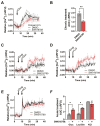Small Molecule-mediated Insulin Hypersecretion Induces Transient ER Stress Response and Loss of Beta Cell Function
- PMID: 35641126
- PMCID: PMC9225822
- DOI: 10.1210/endocr/bqac081
Small Molecule-mediated Insulin Hypersecretion Induces Transient ER Stress Response and Loss of Beta Cell Function
Abstract
Pancreatic islet beta cells require a fine-tuned endoplasmic reticulum (ER) stress response for normal function; abnormal ER stress contributes to diabetes pathogenesis. Here, we identified a small molecule, SW016789, with time-dependent effects on beta cell ER stress and function. Acute treatment with SW016789 potentiated nutrient-induced calcium influx and insulin secretion, while chronic exposure to SW016789 transiently induced ER stress and shut down secretory function in a reversible manner. Distinct from the effects of thapsigargin, SW016789 did not affect beta cell viability or apoptosis, potentially due to a rapid induction of adaptive genes, weak signaling through the eIF2α kinase PERK, and lack of oxidative stress gene Txnip induction. We determined that SW016789 acted upstream of voltage-dependent calcium channels (VDCCs) and potentiated nutrient- but not KCl-stimulated calcium influx. Measurements of metabolomics, oxygen consumption rate, and G protein-coupled receptor signaling did not explain the potentiating effects of SW016789. In chemical cotreatment experiments, we discovered synergy between SW016789 and activators of protein kinase C and VDCCs, suggesting involvement of these pathways in the mechanism of action. Finally, chronically elevated calcium influx was required for the inhibitory impact of SW016789, as blockade of VDCCs protected human islets and MIN6 beta cells from hypersecretion-induced dysfunction. We conclude that beta cells undergoing this type of pharmacological hypersecretion have the capacity to suppress their function to mitigate ER stress and avoid apoptosis. These results have the potential to uncover beta cell ER stress mitigation factors and add support to beta cell rest strategies to preserve function.
Keywords: endoplasmic reticulum stress; insulin secretion; pancreatic islet beta cells.
© The Author(s) 2022. Published by Oxford University Press on behalf of the Endocrine Society. All rights reserved. For permissions, please e-mail: journals.permissions@oup.com.
Figures








Similar articles
-
VDAC1 is a target for pharmacologically induced insulin hypersecretion in β cells.Cell Rep. 2025 Jun 24;44(6):115834. doi: 10.1016/j.celrep.2025.115834. Epub 2025 Jun 11. Cell Rep. 2025. PMID: 40512624 Free PMC article.
-
Target deconvolution of an insulin hypersecretion-inducer acting through VDAC1 with a distinct transcriptomic signature in beta-cells.bioRxiv [Preprint]. 2024 Dec 26:2024.12.26.629558. doi: 10.1101/2024.12.26.629558. bioRxiv. 2024. Update in: Cell Rep. 2025 Jun 24;44(6):115834. doi: 10.1016/j.celrep.2025.115834. PMID: 39763878 Free PMC article. Updated. Preprint.
-
Eukaryotic translation initiation factor 2A protects pancreatic beta cells during endoplasmic reticulum stress while rescuing global translation inhibition.Diabetologia. 2025 Aug;68(8):1735-1753. doi: 10.1007/s00125-025-06431-5. Epub 2025 Apr 30. Diabetologia. 2025. PMID: 40304759
-
Diabetes mellitus and the key role of endoplasmic reticulum stress in pancreatic β cells.Nat Rev Endocrinol. 2025 Sep;21(9):546-563. doi: 10.1038/s41574-025-01129-5. Epub 2025 Jun 4. Nat Rev Endocrinol. 2025. PMID: 40467970 Review.
-
The Role of ER Stress in Diabetes: Exploring Pathological Mechanisms Using Wolfram Syndrome.Int J Mol Sci. 2022 Dec 23;24(1):230. doi: 10.3390/ijms24010230. Int J Mol Sci. 2022. PMID: 36613674 Free PMC article. Review.
Cited by
-
VDAC1 is a target for pharmacologically induced insulin hypersecretion in β cells.Cell Rep. 2025 Jun 24;44(6):115834. doi: 10.1016/j.celrep.2025.115834. Epub 2025 Jun 11. Cell Rep. 2025. PMID: 40512624 Free PMC article.
-
Synchronized proinsulin trafficking reveals delayed Golgi export accompanies β-cell secretory dysfunction in rodent models of hyperglycemia.Sci Rep. 2023 Mar 30;13(1):5218. doi: 10.1038/s41598-023-32322-z. Sci Rep. 2023. PMID: 36997560 Free PMC article.
References
Publication types
MeSH terms
Substances
LinkOut - more resources
Full Text Sources
Medical

